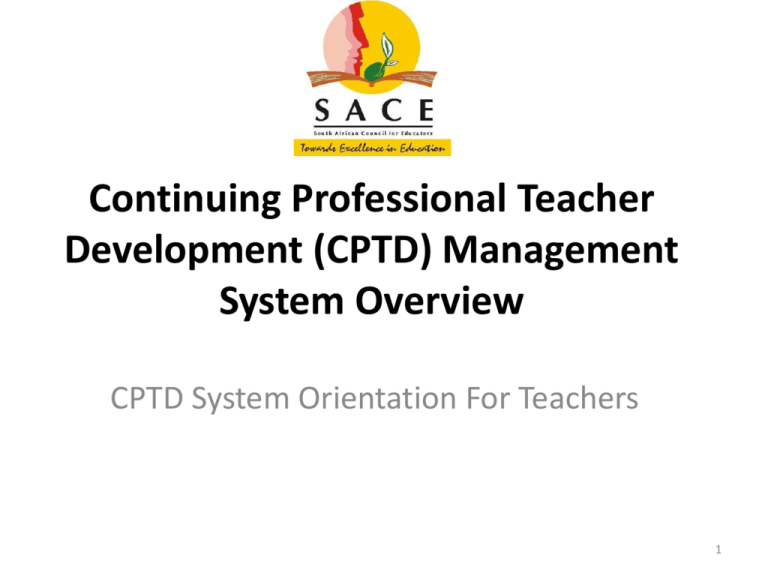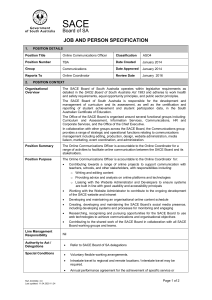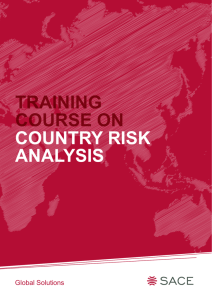CPTD system Presentation PL1 Orientation
advertisement

Continuing Professional Teacher Development (CPTD) Management System Overview CPTD System Orientation For Teachers 1 Content Overview Section 1: Background (Policy and Legislation Context) Section 2: Continuing Professional Teacher Development Management System (CPTD) Section 3: National Pilot 2011/2012 Section 4 : Implementation 2015 and Way-Forward Section 5: Frequently Asked Questions 2 NATIONAL LEGISLATION AND POLICY 3 SACE: Legal Framework South African Council for Educators (SACE) Core mandate (SACE Act no 31(2000) as amended by Basic Education Laws Amendment Act (BELA) no 15 of 2011: Registration of all educators; Manage a system for Continuing Professional Development for all educators (as part of the Basic Education Laws Amendment Act); Ensuring that all educators adhere to the code of professional ethics (SACE code of professional ethics and the disciplinary procedure) Professional Development of Educators CPTD MS – Mandate has its origin in the National Policy Framework on Teacher Education and Development (NPFTED) in South Africa, April 2007, Section 53… “the South African Council for Educators (SACE), as the professional body for professional educators, will have the overall responsibility for the implementation, management and quality assurance of the CPTD System. SACE will be provided with the necessary resources and support to undertake that role “ 4 NATIONAL LEGISLATION AND POLICY 2003 -2004 April 2007 2007 Ministerial Committee on Teacher Education (MCTE) Investigate and develop a teacher education and development framework for the country. • National Policy Framework for Teacher Education (NFTE) National Policy Framework on Teacher Education and Development Gazetted in April 2007 • Policy for Initial Professional Education (IPET) • Continuing Professional Teacher Development (CPTD) systems Conceptualization of design and development of ICT system DoE/ SACE Task Team Reference Group for provincial representation 5 National Policy Context Continue…. June – July 2009 05 April 2011 2012 Teacher Development Summit Basis for new strengthened, integrated national plan for teacher development Launch of Integrated Strategic Planning Framework for Teacher Education in South Africa (ISPFTED SA) Continuing Professional Teacher Development System prominent part in the ISPFTED SA. Connected to Targets and Outcomes of the Action Plan to 2014 National Development Plan Teachers must take responsibility for their own professional development. SACE as professional body must ensure that teachers participate in Continuing Professional Teacher Development activities. On completion – system to earn professional development points towards CPTD as per SACE Council requirement. 6 WHAT IS THE CPTD MANAGEMENT SYSTEM? 7 Why Professional/ Teacher Development? Professional Development (Reasoning) All workers, including professionals , e.g. teachers, doctors, etc. must engage in lifelong learning to improve: – their knowledge; – Skills; – Stay current (keep up to date with new research) Continuing Professional Development of Teachers Better equipped teachers will impact on learner performance 8 NPFTED – Purpose of the CPTD MS 2 Emphasise and reinforce the professional status of teaching... 1 Current initiatives devoted PD of teachers contribute more effectively and directly to... Provide clear 3 guidance about PD activities.... Professional development of teachers 4 Protect teachers from fraudulant providers ... 5 Expand range of PD activities that contribute to.... Improve the quality of teaching and learning outcomes 9 What is the CPTD MS (Overview)…? •It is a system for recognising all useful teacher development activities by: Approving quality and credible professional development providers; Endorsing relevant and good professional development quality activities and programmes Allocating professional development (PD) points to such activities; Crediting each teacher’s CPTD account/record with the PD points they have earned. Note: (i) SACE is not a provider of professional development activities / programmes; (ii) The CPTD Management System will not provide professional 10 development activities to teachers. What will SACE Do? • SACE will, through the CPTD Management System, encourage and recognise: – what educators do on their own to develop themselves and improve learning, – what educators do as part of the school collective to develop themselves and improve teaching, learning, assessment and service to the community and – what educators do to develop themselves and improve teaching, learning, assessment and service to the community by taking advantage of good quality services provided by employers, unions, professional associations, HEIs and others 11 Types of Professional Development Activities Educators Engage in Three Kinds of SACE Endorsed Professional Development (PD) Activities / Programmes Teacher Initiated Type 1 Pre-Determined PD Points Allocated by the teacher on his/her own in line with the SACE PD Points Schedule School Initiated Type 2 Header Pre-Determined PD Points Allocated by the teacher on his/her own in line with the PD Points Schedule from SACE Externally initiated Type 3Header Approval of provider Endorsement of activity PEDs, Unions, NGO’s, Private providers, Higher Education Institutions, Professional Associations SACE Catalogue / Database of approved Providers and Endorsed Activities (SACE Website / Disk Format) 12 • • • • • • • • • • • • • EXAMPLES OF WHAT COUNTS AS PD ACTIVITY / PROGRAMME – TYPE 1 (Teacher Initiated/Self-Chosen) – Excluding Employers’ Activities Personal Development, Work-Based Learning, Professional Activities • Reading Educational Material from Various Publications and Sources • Engaged in Electronic Media Educational Activities (webinars, online PD, viewing / listening to an • educational programme, telematics, APPs / ICT training / Virtual School / Portal) • Online PD Activities Attending Educational Meetings / Breakfast Sessions (Excluding the ones by Employers / • PEDs) • Attending Educational Conferences / Workshop • Sessions (Excluding the Employer/PEDs driven ones) • Mentoring and Coaching Researching and Developing Kick-starting and / or leading a community project Facilitating a workshop session Presenting a conference/seminar paper • Organising activities of a conference / workshop / seminar / subject committee / professional association Being an External Examiner / Assessor / Moderator • • Marking / Assessing Participating in a PLC outside the school Qualifications/Short Courses (Self-Payment) Participating in a professional association (e.g AMESA, SAPA, EMASA, SACEE and others) Developing learning / workshop material and / or related resources Discussion with colleagues Participating in educational book clubs Keeping PDP (Reflective Practice and Professional Journey) Visiting and learning from other schools (local, district, provincial, national, regional and international), reporting back and implementing what you have learned Participating in 1 self-funded activity responding to the national priorities as determined by Minister / CEM Lekgotla Writing articles for various educational purposes Responding to 2 developmental needs from the 13 needs identification processes EXAMPLES OF WHAT COUNTS AS PD ACTIVITY / PROGRAMME – TYPE 2 (School-Led/Initiated) Collective, School-Based and School-Focused Professional Development, Professional Collaboration, Collegiality • School Meetings (initiated at school level and led by different role players – excluding the Provincial Education Departments / Districts and Circuits) • School Workshops / Development and Support Sessions • School Seminars / mini conferences • School Community Action Research • School projects • Achieving two school developmental needs (e.g through SIP, APIP) • School Twinning / Networks • Responding to school results (ANA/NSC) diagnostic reports • PLCs at school level • Subject Cluster Meetings 14 EXAMPLES OF WHAT COUNTS AS PD ACTIVITY / PROGRAMME – TYPE 3 (Employer-Led / Other Provider-Led) OTHER PROVIDERS: – – – – • Teacher Unions Higher Education Institutions Private Providers NGOs / Community-Based Organisations / Faith-Based Organisations – Other Government Departments – Professional Associations Approved Providers’ Endorsed Programmes / Activities from the SACE database or catalogue – workshops, – short courses/skills programmes, – full qualifications, – online programmes, – unit standard-based part qualifications) EMPLOYER-LED : : (DIP, PIP, National Priorities, Sector Priorities) • – Provincial Education Departments (Including Districts, Circuits, PTDIs/MASTEC, DTDCs) – SGB Associations – Independent Schools Associations / Groups / Boards) Employer – Led PD Activities – Meetings – Workshops – Subject Committee – Facilitating Workshop/Training Sessions (e.g. Lead Teachers) – Self Diagnostic Assessment – Seminars / Conferences – Onsite Support in Schools – Subject Committees – Induction Programmes – Short Courses / Skills Development Programmes 15 – Full qualifications (where funding is offered) The Basic Structure of the CPTD System • Educators have to earn their Professional Development Points from each of the three types of Professional Development Activities • Each educator will be expected to achieve 150 PD points on their PD points Account in every three year cycle. • SACE will issue a Certificate of Achievement to each educator who achieves the 150 PD points within the three years as follows: – Bronze Certificate of Achievement to each educator who achieves 150 - 199 PD points within the three years. – A Silver Certificate of Achievement to each educator who achieves 200 to 299 PD points within the three years. – A Gold Certificate of Achievement to each educator who achieves 300 and above PD points within the three years.16 CPTD SYSTEM TARGET AUDIENCE 17 CPTD System Target Audience • In terms of the NPFTED (2007) the CPTD Management System will be made available to all school-based educators (principals, deputy principals, HoDs, teachers / Grade R to 12 in schooling) whether: – state-employed, – employed by School Governing Bodies, or – employed by independent schools • From 2015 onwards, SACE will include the final year student teachers in the CPTD system orientation and sign-up process • It is important to note that the CPTD-IS is being refined to accommodate them for two reasons: – They do not have schools as yet, and one need a school to continue with the online sign-up process in particular – Most of them have provisional registration numbers. The system will allow them to use their provisional numbers and update them upon receipt of the SACE full registration status 18 CPTD System Target Audience.. • The CPTD system is not applicable to the – – – – ECD Practitioners AET Practitioners, FET College Lectures Teachers relieving others or occupying a position for less than 12 months • What about the Therapists and Psychologists in Schools? – The Therapists and Psychologists belong to the Health Professions Council of South Africa as professionals – They also register with SACE by virtue of them working in schools with our children – They have their own CPD system with 1 year cycle and have to earn 60 points in that cycle – SACE started a process of engaging the HPCSA on this matter for purposes of collaboration and minimising duplication in terms of reporting. The discussions are at early stages. – In the light of this, SACE requires that Therapists and Psychologists in schools sign-up for participation in the CPTD Management System from 2015 onwards – SACE will continue its engagements and provide the therapists with direction on recording and reporting their participation in PD activities and points earned at a later stage 19 WHAT HAPPENS BEFORE YOU START WITH YOUR THREE YEAR CPTD SYSTEM CYCLE? 20 SIGNING-UP FOR PARTICIPATION IN THE CPTD MANAGEMENT SYSTEM • EACH COHORT MUST SIGN-UP FOR PARTICIPATION IN THE CPTD SYSTEM, A YEAR BEFORE THEIR THREE YEAR CYCLE STARTS WHAT IS THE PURPOSE OF THE CPTD SYSTEM SIGN-UP? • Create individual CPTD Accounts / Records of educators’/schools’ participation in the CPTD System and professional development uptake • Provide educators with login details (username and password) through an sms so that they can access the CPTD self-service portal for purposes of: – Updating personal details on regular basis – Uploading their participation in type 1 Professional Development activities and PD Points – Searching for the approved providers and endorsed PD activities / programmes – Tracking / Monitoring PD Activities and Points Account – Online Portfolio – Log a query / Report a problem to SACE • Create a clean and updated database of educators and schools with relevant information / fields / variables for teacher education and development purposes (possible link ups with SA SAMS, EMIS, SACE Registration, SAQA qualification validation) • In addition, the sign-up data is being used to develop a report with statistical and narrative information to indicate the state of the teaching profession with regard to the principals, deputy principals, HODs and 21 teachers and ultimately inform planning and policy decisions. SIGNING-UP FOR THE CPTD MANAGEMENT SYSTEM HOW DO I SIGN-UP? You can sign-up as follows: Manually • By filling-in the teacher profile form obtainable from the: – SACE website/offices, – CPTD system orientation workshop sessions, – Provincial Education Departments’ teacher development units / District Teacher Development Centres, Provincial Teacher Development Institutes, – SACE Provincial Offices in KZN and Free State • The completed form should be: – handed over to the workshop facilitators (if sign-up took place during the workshop session)] – faxed to SACE (086 571 5260) – Posted to SACE, PD and Research Division (Private Bag x127, CENTURION, 0046) – E-mailed to member@sace.org.za 22 SIGNING-UP FOR THE CPTD MANAGEMENT SYSTEM Electronically through the CPTD Self-Service Web Portal as follows: • • • • • • Go into www.sace.org.za Click on the CPTD Tab on top and choose “CPTD Self-service portal” It will take you to the CPTD Sign-Up Screen. Then Choose EDUCATOR SIGN-UP” Choose South African Educator or Foreign Educator Enter your details (Name, Surname, SACE Number and ID Number). Remember ID number is a mandatory field. • PLEASE NOTE THAT – IF YOU DO NOT ENTER THE SACE REGISTRATION NUMBER, WHEN YOU SIGNUP, THE SYSTEM WILL SEND YOU A MESSAGE WITH A TEMPORARY USERNAME AND PASSWORD. – YOU WILL HAVE 60 DAYS TO REGISTER WITH SACE AS AN EDUCATOR AND UPDATE YOUR CPTD RECORDS WITH THE SACE REGISTRATION NUMBER. – IF YOU ARE A SACE REGISTERED EDUCATOR AND FOR SOME REASONS YOU DID NOT ENTER YOUR REGISTRATION NUMBER, WHEN YOU SIGN-UP, YOU WILL STILL RECEIVE SMS WITH TEMPORARY USERNAME AND PASSWORD. – PLEASE UPDATE YOUR CPTD RECORDS WITH THE SACE NUMBER AS SOON AS POSSIBLE. ONCE THE SACE REGISTRATION NUMBER UPDATE IS DONE, YOU WILL RECEIVE SMS WITH A NEW USERNAME (YOUR SACE NUMBER) AND PASSWORD (YOUR SURNAME). YOU HAVE AN OPTION OF CHANGING YOUR 23 PASSWORD. WHAT HAPPENS AFTER SIGNING-UP? PARTICIPATION IN THE THREE-YEAR CPTD SYSTEM CYCLE BEGINS 24 THE THREE COHORTS AND THE CPTD SYSTEM CYCLES AT GLANCE 2013/14 • Sign-up and Orientation for Principals and Deputy Principals 2014/15 • 1st year of the Principals and Deputy Principals’ three year CPTD system cycle • Sign-up and Orientation for the HODs 2015/16 • 2nd year of the Principals and Deputy Principals’ three year CPTD system cycle • 1st year of the HODs’ three year CPTD system cycle • Sign-up and Orientation for the Secondary and Combined PL1 Teachers – start the 1st year of the three year cycle in 2016 25 How will the process unfold? •Teachers will be able to: Process Reflect Identify Needs Access Own professional competence and practice: Improve knowledge (content) Improve and apply their skills (methodology/ teaching practise) Stay current Through processes such as: Performance Management System (e.g. IQMS, and others) ANA / NSC Diagnostic Reports Teacher Self-Diagnostic Assessment Others Appropriate opportunities for professional development By learning from colleagues; Communities of practise (cluster level); School-based professional development / on-the-job learning; Self-Development Employer-driven PD activities / programmes SACE approved providers 26 Integrated Quality Management System (IQMS) & CPTD How does IQMS relates to CPTD – IQMS is a system that is used to help educators to identify their professional development needs and address them through various SACE Endorsed PD activities / programmes. – It also caters for performance evaluation of educators. – The CPTD System recognises all useful quality professional development activities/ programmes. – These PD activities/ programmes are informed by the identified needs from IQMS processes. – They must also enable teachers to improve teaching and 27 learning and ultimately earn PD points. Integrated Quality Management System (IQMS) & CPTD MS How does the IQMS process unfolds and relates to the CPTD MS STEP 1: Teachers are at the centre of the education system. They take responsibility for their own professional development. The key goals of professional development is to improve classroom practice and learning outcomes. STEP 2: Teachers identify PD needs through IQMS and other related processes. STEP 3: Teachers develop their professional development/growth plan and choose activities that will help them address the identified needs from the database of the SACE approved providers and endorsed PD activities. STEP 4: Teachers participate in quality SACE Endorsed Professional Development Activities / Programmes (Teacher / School / Externally initiated) in order to improve teaching and learning. STEP 5: Teachers earn PD Points from the SACE Endorsed PD activities / programmes they participated in over a three year cycle. 28 How does IQMS process relates to the CPTD MS Process? Teachers’ summative turns to baseline evaluation Developmental needs are identified Teacher / School / and SACE Endorsed Externally Activities in response to the needs are chosen/selected Teacher decides on activities Teacher participates in continuing professional development Participation in and completion of activities leads to accumulation of PD points 29 HOW DO I EARN THE PD POINTS FROM THE THREE TYPES OF PD ACTIVITIES / PROGRAMMES? 30 PARTCIPATING IN PD ACTIVITIES AND EARNING PD POINTS Reflect on the needs you have identified last year and how you have addressed them yourself, through the school, and through your employer and other providers Teacher Initiated Type 1 Teachers will need more of the Professional Development Points Schedule and less of SACE catalogue of Endorsed PD Activities to allocate PD Points to their self-chosen professional development activities / programmes School Initiated Type 2 Header NOTE!! Your need more of the Professional Development Points Schedule and less of SACE catalogue of Endorsed PD Activities to allocate PD Points to your school-initiated professional development activities / programmes The SACE Catalogue of Approved Providers and Endorsed Activities will only be used in instances where an educator participated in a PD Activity / Programme with a duration of 6 days and above. For example, 6 days workshop, full qualification(ACE, ADE, Honours, Masters etc), 1 – 12 months 31 short courses and others January – December Typical PD Activities Type 1 Type 1 PD Activity Pre-Determined PD Points 8 Educational Meetings (per annum) (NOT BY THE EMPLOYER) 1. 3 x Union Educational Meeting / Forums 2. 3 x Meetings on Networking with Local Schools / Twinning 3. 2 x Meetings by Professional Association (e.g. AMESA, EMASA and others) 10 Points (all together in a year for 8 meetings) 6 Points if you have participated in 4 meetings in a year 4 Points if you have participated in 2 meetings in a year Conferences / Symposium / Breakfast Sessions / Workshops 1. Teacher Union Education Conference/Seminar 2. Professional Association Provincial Conference 3. Breakfast Session by NGO 4. Workshop Session on a particular Subject or field by a provider 10 Points (1 day) 15 Points (2 days and more) 5 Points (2 – 5 hours) 5 Points (2 – 5 hours) Reading Educational Material (from 4 sources in a year) Union educational publication – articles on new policies and legislation and ELRC agreements/ Magazine – article on Assessment / Book on subject content/ The Teacher Newspaper / Periodicals on the subject I am teaching/ Journal on your pedagogical content 10 Points (4 sources) ACE / ADE / HONOURS / Master by .... Higher Education Institution 12 Months Mentorship Short Course by.... HEI Assessor 3 months course by.... Provider PD Points Obtainable through the SACE Catalogue of Endorsed PD Activities Plus 5 PD Points (Additional 2 sources) 32 Type 1 PD Activity Pre-Determined PD Points January – December Typical PD Activities Type 1...... Facilitating a workshop session – 10 Points for facilitating a full day workshop session Engaged in Electronic Media Educational Activities for 30 – 60 minutes (Such as, radio, television, broadcasting, virtual programme, computer, and others) 6 activities per annum in order to earn 12 points . 3 activities per annum, you will earn 6 points Listening to educational programmes on radio/CD, Viewing educational programmes on TV , Participating in a PD Programme through live/recorded broadcast from a studio / webinars / telematics, online, Watching / Viewing educational DVD / Video, Completing online self-diagnostic assessment Undertaking research in teaching and learning for a year 20 PD Points Researching and developing material for reading and writing within 10 PD Points the 6 months period Researching and writing an article or paper for the magazine / journal / educational newspaper etc. Within the 6 months period TOTAL NO. OF TYPE 1 PD POINTS EARNED IN A YEAR 10 PD Points 33 January – December Typical PD Activities Type 2 Staff Development (4 per annum) – SIP / APIP 20 Points (all together) • Conducting / Facilitating subject-related , management and leadership and other educational matters workshop sessions for colleagues at a school • Attending and participating in 2 school-based ANA/NSC PD activities / programmes • Being developed and supported on a particular subject , educational matter, or management and leadership area by peers within and from other schools / SMT • Implementation of an intervention that respond to the School Results Diagnostic Report (e,g, ANA, IEB, NSC and others) 15 Points School Projects • Implementing action research school project 20 Points School Meetings (10 per annum). For example: • 2 x SGB Meetings • 4 x Staff Meetings • 5 x Feedback meeting session (if an educator/SMTs participate in an external PD activity and provide feedback to the entire school) 10 Points Participating in a PLC at a school over 12 months 12 TOTAL NUMBER OF TYPE 2 PD POINTS EARNED IN A YEAR 77 Points 34 TYPE 3 PD ACTIVITIES You will need more of SACE Catalogue of Approved Providers and Endorsed PD Activities and less of Professional Development Points Schedule in order to allocate PD Points to your Type 3 Activities / Programmes PRE-DETERMINED • Less than 6 days PD Activities / Programmes • Submission to SACE on a Pre-determined PD Points Form • Allocation of Pre-Determined PD Points Through the PD Points Schedule FORMAL ENDORSEMENT • 6 days and above PD Activities/Programmes following formal evaluation process (2 – 3 months) • Provider will have an approval letter and PD activity/programme Endorsement Certificate from SACE •• Both the approval letter and Endorsement Certificate expires after 3 years from the date of issue. • Providers / Employers must re-apply for approval and endorsement 6 months before expiry date 35 • PD Points allocated through the SACE Catalogue of Endorsed PD Activities January – December Typical PD Activities Type 3 Type 1 PD Activity Pre-Determined PD Points 4 Educational Meetings (per annum) (BY THE EMPLOYER ONLY) 1. 2 x District Educational Meetings 2. 1 x Circuit Educational Meeting 3. 2 x Independent School Association Educational Meetings 6 Points (all together in a year) Less than 5 Days Workshop Sessions By the Employers / SACE Approved Providers / Independent School Associations (Earn PD Points Per Workshop Session) – DIPS/PIPs/PIVOTAL 1. Attending one day District office workshop session on new policies and legislation 2. Attending one day District Teacher Development Centre workshop on ICT 3. Attending 2 days Leadership programme by the teacher union 4. Attending half-day workshop session by a private provider / NGO on behalf of an employer 10 Points (1 day) 10 Points (1 day) 15 Points (2 – 5 days) 5 PD Points Conferences / Seminars / Summits / Indabas etc. 1. Attending half-day seminar by employer on corporal punishment 2. Attending 1 and half day education summit or indaba by employer or SGB / Independent School Association 5 Points 10 Points 1 x 30 minutes one-on-one onsite support by the Subject advisor / officebased official 5 Points 36 January – December Typical PD Activities Type 3 Type 1 PD Activity Pre-Determined PD Points 6 Days and Above Workshop Sessions / Courses / Full Qualifications By the Employers / SACE Approved Providers / Independent School Associations (Earn PD Points Per Workshop Session) – DIPS/PIPs/PIVOTAL PD Points Strictly Obtainable through the SACE Catalogue of Endorsed PD Activities 1. Completing a SACE Endorsed ADE offered by SACE Approved HEI 2. Completing a SACE Endorsed 12 months Mentorship Programme by a SACE Approved Private Provider 3. Attending a 3 months SACE Endorsed subject content / leadership course by the SACE Approved Provincial Education Department’s Institute 4. Attending 6 days SACE Endorsed workshop session on curriculum management by SACE Approved teacher union 45 Points 40 Points 35 Points 20 Points Conferences / Seminars / Summits / Indabas etc. 1. Attending half-day seminar by employer on corporal punishment 2. Attending 1 and half day education summit or indaba by employer or SGB / Independent School Association 5 Points 10 Points PLEASE NOTE: Teacher will not be able to earn PD Points from 6 days and above PD activities and programmes that are NOT SACE Endorsed 37 HOW DO I RECORD AND REPORT MY PARTICIPATION IN TYPE 1 – 3 PD ACTIVITIES / PROGRAMMES AND PD POINTS EARNED? 38 Recording Systems •How do I RECORD my PD activities? – Teachers will be required to record their • Identified Needs • Professional Development Plans responding to the identified needs, • Participation in PD activities / programmes and PD Points earned in their Professional Development Portfolios (PDPs) – The PDP is available online and offline – SACE expects educator to record and report their PD activities and points honestly. Dishonest recording and reporting is an unprofessional conduct. It may also be a breach of SACE’s Code of Professional Ethics – Teachers are NOT required to send their PDPs to SACE – The PDPs will be used to MONITOR and SUPPORT Teachers’ Participation in the CPTD system and Professional Development Uptake – SACE will monitor a representative sample of educators’ PDPs each year to see how educators are using the system, and will provide feedback on its findings to the educators and schools concerned – As part of their IQMS process, teachers must use the same information / portfolios (PDPs) for their formative and summative evaluation processes; – In this way teachers fulfil both the IQMS and CPTD System requirements. 39 Professional Development Portfolio (PDP) •PDP developed according to SACE Guidelines PDP provide advise and support on professional development Access: • School principal or delegated SMT member, A • Authorised representative of an educator’s employer • An authorised SACE representative B Personal record of educator’s professional development journey. • Own property; • Principal and SMT – monitor their educator’s PD participation and discuss improvements (departments, staff, individually) • SACE will monitor representative sample each year, provide feedback. 40 Professional Development Portfolio (PDP) •PDP developed according to SACE Guidelines and Templates C Resource document to assist each educator’s professional growth. Advise on understanding and analysing professional development needs; Educator’s analysis of PD needs; Guidance – how to undertake or access PD activities information on CPTD MS; A record and evidence of the educator's PD activities and PD points earned. 41 Reporting Participation in PD Activities.. •How do I REPORT my PD activities and Points Earned? An educator will report his or her participation in teacher and school initiated PD activities and Points earned according to the SACE PD Points Schedule. Externally initiated PD activities will be reported according the PD Points allocated to the Providers in line with his / her SACE endorsed PD activities (These Points are obtainable from the concerned provider or the SACE Catalogue/Database of Endorsed PD Activities) Educators MUST report their participation in Professional Development twice a year manually on a form obtainable from the Professional Development Portfolio Template or electronically on the CPTD self-service portal twice a year – May to June and October to November 42 Reporting Participation in PD Activities • How do I REPORT my PD Activities and Points Earned Manually / OFFLINE? The manual reporting templates are obtainable from the Professional Development Portfolio which is available on the SACE Website CPTD System Self Service Web Portal Offices and CPTD system orientation workshop sessions in provinces •The completed templates should be Faxed to: 086 571 5260 Posted to: SACE, Private Bag x127, CENTURION, 0046 E-mailed to: member@sace.org.za 43 Reporting Systems.. How do I REPORT my PD activities and Points Earned Electronically/ ONLINE? .... PLEASE NOTE: It is very important to upload/record/report your PD Points according to the PD Points Schedule / Educator’s Guide on How to Participate in My three year cycle. For example, according to the SACE PD Points Schedule you need 8 meetings per annum to earn 10 PD Points under Teacher Initiated Activities. In line with this requirement, you will only earn 10 PD Points after loading/recording / reporting 10 different meetings. If you upload/record/report 3 meetings in June, for example, your ACTIVITIES COMPLETED will show the three meetings you have participated in. Your PD POINTS ACCOUNT will, however, show 0 until you upload / record / report the remaining five (5) meetings in August, for example.. 44 CPTD MS – Flow of Process •Overview of process over three year cycle Cycle completed. Certificate: Bronze (150) Silver (150 to 300) Gold (300+) Evidence: Professional Development Portfolio Teacher identify PD needs (PMS) SACE Pre-Endorsed PD Activities (From the ... SACE PD Point Schedule) Approval Endorsement Monitoring and evaluation Teacher engages in PD Activities PD points allocated Upload on Information System (IS) 45 NATIONAL CPTD SYSTEM PILOT 2010 - 2012 46 National Pilot and Outcome •2010 - 2012 Aim of pilot To test and assess the state of readiness of the following components for the implementation of the CPTD MS: Advocacy and communication; CPTD Information System (IS); Endorsement Process; Provider Capacity; Management and administrative support and capacity; Financial Investment. Outcome Changes made to system: Minimum rule of 30 points suspended per category; No punitive measures for first phase of implementation; The criteria and process for endorsement have been simplified; The conceptualisation of type 1 and 2 activities has been modified. CPTD Status report on SACE’s website Participants 13 Districts 145 Schools 3900 Teachers 14 Implementation and Way-Forward 48 3 COHORTS AT A GLANCE PRINCIPALS / DEPUTY PRINCIPALS 2013 Sign-up 2014 three year cycle started HODs 2014 Sign-up 2015 three year cycle started PL1 TEACHERS 2015 Sign-ups 2016 three year cycle starts 49 THIRD COHORT ORIENTATION SIGN-UP The third cohort will be split into two years due to the current funding inconsistencies, PEDs performance trends, capacity, numbers: January – December 2015 January – December 2016 110 000 Secondary and Combined School Teachers from approximately 8000 schools Approximately 7000 Final Year Student Teachers studying BED and PGCE (face-to-face, distance, learnership) First Three Year Cycle (2016 – 2018) Primary School Teachers Special Education Needs School Teachers Final Year Student Teachers Therapists and Psychologists employed as educators in terms of the EEA of 1998 50 Three Year Cycle (2017 – 2019) WAY-FORWARD • Ongoing Collaboration with Stakeholders • Ongoing CPTD System Advocacy and Communication • Electronic / Manual Sign-ups by PL1 Teachers and Final Year Student Teachers • Orientation of Secondary and Combined School PL1 Teachers and Final Year Student Teachers • Familiarising yourselves with the CPTD system material, processes and CPTD Information System • Principals, Deputy Principals and HODs report to SACE, their participation in Type 1 PD activities and PD Points earned twice a year • Principals, Deputy Principals and HODs record their participation in PD activities in their Professional Development Portfolio 51 FREQUENTLY ASKED QUESTIONS 52 Frequently Asked Questions Is participation in professional development / CPTD System compulsory? What happens if teachers don't reach the 150 points target ? Yes… Participation in professional development / CPTD System is mandatory for all teachers. Professional development is part of SACE’s Code of Professional Ethics for educators. All teachers commit themselves to observe the Code. Section 7 of SACE Code of Professional Ethics states that an educator: -“must keep abreast of educational developments” SACE expects and encourages all teachers to sign up for the CPTD Management System as it rolls out so that they keep up to date and on their toes professionally First six years – SACE will not impose a penalty on teachers not reaching target; SACE will review and make a decision about non-compliance. However, educators who refuse to participate in the CPTD Management System OR defy it will be contravening Section 7 of the SACE Code of Professional Ethics 53 Frequently Asked Questions What do you need to do after CPTD orientation and sign-up? Who will fund the PD Activities? Start participating in the CPTD 3 year cycle from 2016 onwards by: Updating your information regularly on the CPTD Self-Service web portal Start developing your PDP in terms of Planning, Recording Evidence of Participation in three types of PD Activities and REPORTING Your Participation and PD Points to SACE by May/June and October November PL1 Teachers will only start earning PD points from the beginning of 2016. Start discussions in your phase/ department/site / Forums / cluster meetings / staff rooms / staff meetings / union gathers / professional association meetings about the CPTD MS. Only SACE-endorsed activities offered by SACE approved providers should be funded by employers. Type 1 activities does not necessarily need funding. Type 2 activities based on allocation made by SGB for professional development. 54 System needs – by employers Frequently Asked Questions You should: Go to FORGOT MY PASSWORD on the Educator Login Screen WHAT HAPPENS IF I LOOSE MY USERNAME AND/OR PASSWORD? Enter the cell number you used when you signed-up OR the last updated cell phone number Receive sms with username and password Alternatively, contact SACE’s PD and Research Division (012 663 9517/ member@sace.org.za / 086 571 5260) to re-issue your username and password. NB: Please provide SACE with your Surname, Full names, ID or SACE number to be able to search for your forgotten username and password when you call or send an email/fax. NOTE: IF YOU DO NOT HAVE ACCESS TO THE INTERNET, SACE WILL MAKE THE INFORMATION ON THE CPTD SELF-SERVICE PORTAL AVAILABLE TO YOU MANUALLY. WHAT HAPPENS IF I AM PROMOTED IN 2015? • TEACHERS promoted to HOD, OR Deputy Principal OR Principal Positions, throughout the year, continue with their 2016-2018 cycle (will have a different cycle as compared to the rest of the 1st and second cohort) 55 THANK YOU SACE PRIVATE BAG X 127 CENTURION 0046 012 663 9517 member@sace.org.za 086 571 5260 (Fax to Email) www.sace.org.za 56









